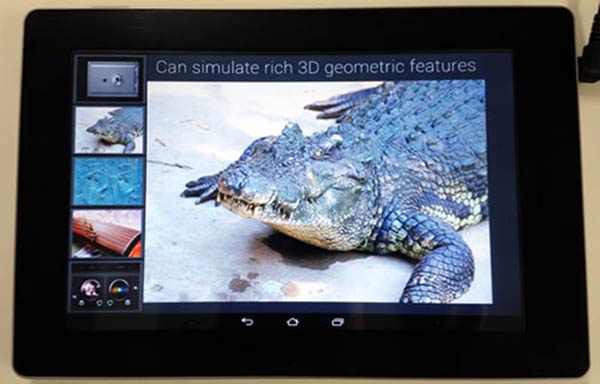Fujitsu has recently developed a prototype tablet with a screen that can convey the feel of different textures depending on the image being displayed. This new haptic-tactile sensory technology was developed by Fujitsu Laboratories and is currently being shown off at the MWC in Barcelona.
Whilst is it no innovation to convey texture by the use of vibration or static electricity, the technology used here is said to be the industry's first to employ "ultrasonic vibrations to convey tactile sensations by varying the friction between the touchscreen display and the user's finger."
Both rough or smooth tactile sensations have been hard to achieve previously. However the Fujitsu ultrasonic haptic feedback technology now allows users to experience realistic tactile sensations such as slipperiness, roughness, bumps and edges - depending on the objects displayed on the screen.

The technology works with ultrasonic vibrations creating a high-pressure layer of air between the screen's surface and a user's fingertip, this in turn reduces friction and creates a floating effect. Areas of high and low friction are then created along the lines of the image which generates the difference in tactile sensations. Fujitsu has managed to reduce the amount of energy needed to create vibrations in the ultrasonic band required for this functionality making the tech deployable in mobile devices.

"Fujitsu's method of using ultrasonic vibrations achieves an unprecedented slippery sensation, while keeping noise to a minimum," said a Fujitsu spokesperson. "We are proud of the advanced audio and visual technologies our products offer, and with this new technology, we are exploring ways to appeal to even more senses for a more complete experience."
Demonstrations at the MWC trade show today allowed users to turn combination locks, stroke an Alligator and even pluck the strings of a Japanese harp. Though the sensations may not be completely realistic, we can imagine the combination of tactile, visual and audio information does provide a more enriched user experience. If the technology is developed further, we can expect to see it employed in areas such as online shopping where users can feel the material of clothing they are buying or photography where stroking wild animals will become possible. Has anyone got any other ideas where this tech would be a positive addition to a tablet?
We are told that Fujitsu plans to employ the technology into commercial hardware by 2015, hoping to offer consumers an original experience in usability and sensory expressiveness.













